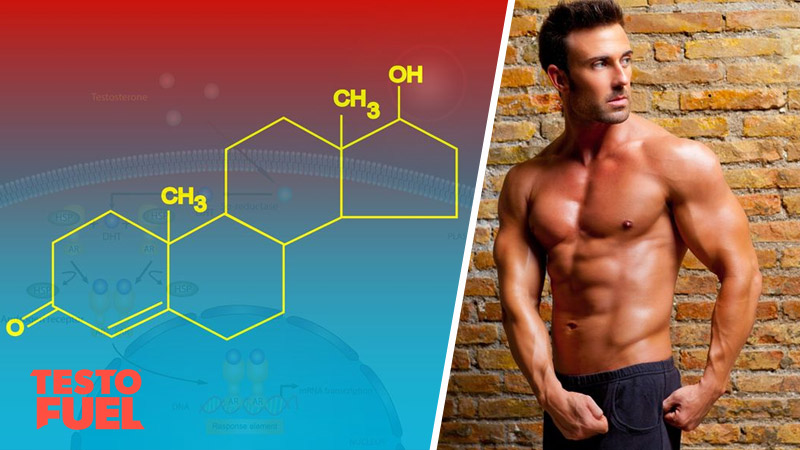TestoFuel Blog : Make Gains & Pack on the Muscle

Testosterone is the hormone responsible for giving you your muscular frame, your athletic performance and your confident, assertive presence.
This powerful anabolic not only keeps you looking great but feeling well too – it’s an important regulator of cardiovascular and metabolic health as well as cognitive well-being.
If you’ve ever wondered whether your testosterone levels fall into the normal category or not then this article is for you.
Read on to find out more…
Produced in the Leydig cells of the testes, testosterone is the king of male hormones.
It controls masculine development and as such is classified as an androgen, alongside dihydrotestosterone (DHT) and androstenediol.
Testosterone has two main actions when it comes to promoting masculinity:
When your T levels are optimized, your body runs more efficiently.
You find it easier to stay lean and muscular, keeping belly fat down and the muscle mass dial ramped up to maximum.
And it’s not only muscle mass that stays elevated. Bone mass maintains its development too.
Your risk of long-term illnesses such as obesity, diabetes and cardiovascular disease remains low, helping with quality of life.
Lastly, optimal testosterone helps you maintain a high libido, good sexual appetite and develop good stamina too, both in the gym and out of the bedroom.
Although released directly from the testes, T is tightly regulated by an extremely precise feedback loop – the hypothalamic-pituitary-gonodal axis (HPG).
This system is made up of the hypothalamus and the pituitary glands, which are both situated in the brain. The gonadal part refers to your gonads or reproductive tissue.
When your body needs more testosterone in your blood this is what happens.
This complex system is called a negative feedback loop purely because once your testes begin to pump out enough T, a message is sent back to the hypothalamus to tell it to inhibit or calm the release of GnRH.
This in turn completes a ‘loop’ between all glands and hormones.
Once your Leydig cells release testosterone into the bloodstream it needs to be taken up by the various target androgen receptors and cells in your muscles, fat, brain and so on.
The problem is though that most of this circulating T get bound up by two proteins – sex hormone binding globulin (SHBG) and albumin.
In fact, only around 3% of the testosterone in your blood is available to be taken up by your androgen receptors – the rest is unusable.
Your total testosterone is that T in your blood that is either bound or unbound by SHBG.
Your Free T is that which is unbound from SHBG and ready to be used by your cells (the binding with albumin is only loose and therefore can still be used).
Once you hit puberty, your T levels increase dramatically. Almost overnight you start to develop male characteristics – your voice drops and you begin to develop body hair. You height increases rapidly, your muscle mass increases and you get stronger.
Your testosterone should then remain elevated through to your early thirties. Here’s what clinicians govern as the reference range or ‘normal’:
| Total Testosterone | 300-1,000 ng.dL |
| Free Testosterone | 5-21 ng.dL |
And this table shows you the reference values for total T based on age [1]. This gives you a more detailed view of what your’s should be.
| Age (years) | Mean Total Testosterone (ng.dL) |
| Under 25 | 692 |
| 25-29 | 669 |
| 30-34 | 621 |
| 35-39 | 597 |
| 40-44 | 597 |
| 45-49 | 546 |
| 59-54 | 544 |
| 55-59 | 552 |
Your hormone levels will naturally fluctuate throughout the day as your body constantly balances itself out.
T levels are at their highest in the morning so that’s when you should be measuring it if you’re doing it yourself.
From the age of around 30, your testosterone levels fall by 1-2% per year. This can lead to a drop of 30% or more by the age of 65-75 [2].
Your free testosterone can plummet even further – by around 50% [3].
As you pass the peak hormone age of 18-30 your testosterone will begin to naturally decline.
When your T levels fall below the total testosterone value of 300 ng.dL you will be diagnosed with clinically low T or hypogonadism.
As a consequence of this you’ll find it harder to maintain muscle mass, strength and athleticism.
And those aren’t the only side effects either. You can also expect:
By exercising regularly, eating the right foods and taking the right supplements you’ll fight the natural taper of your male hormones and reap the health and performance goals at the same time.
Testosterone really is the key to longevity.
Testosterone is responsible for making you a man. It controls everything from your muscle mass to your broad shoulders and deep voice.
Normal reference range total testosterone levels fall between 300-1,000 ng.dL. This includes the T that is available to be taken up by androgen receptors, but also that bound to SHBG too.
As you hit puberty your T levels rocket. But as you age they slowly begin to decrease. It is important for physical health, performance and well-being that you do all you can to maintain optimal, normal testosterone levels.
You can give your hormone levels a boost by taking TestoFuel – an all-natural male support complex, specifically designed to elevate your testosterone in a safe and effective way.
Containing ingredients such as vitamin D3, magnesium and D-aspartic acid, TestoFuel has the power to: